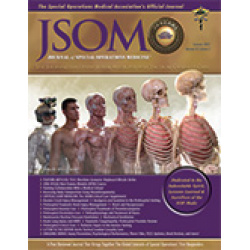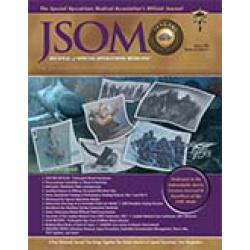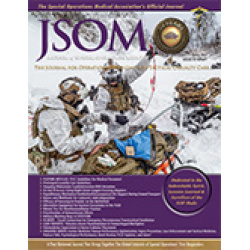Breakaway Media, LLC

Lampman P, Kennington K, Assar SM 22(2). 63 - 68 (Journal Article)
Shock is a life-threatening condition carrying a high mortality rate when untreated. The consequences of shock are cellular and metabolic derangements, which are initially reversible. The authors present the case of a Servicemember who sustained mortar shrapnel wounds that resulted in shock.
Ditzel RM, Hwang BY, Schmid JH, Ling GS 22(2). 55 - 61 (Journal Article)
Traumatic brain injury (TBI) management is complex. The brain is a sensitive, high-maintenance organ that loses its ability to take care of itself upon injury, and our primary mission is to achieve and maintain optimal levels of cerebral blood flow (CBF) from the moment of injury until recovery. The authors provide a case and discuss prehospital patient management, including adequate oxygen saturation and blood pressure, early recognition of TBI, frequent exams, detailed charting and hand-off, and fast transport to the next echelon of care.
DesRosiers TT, Anderson JL, Adams B, Carver RA 22(2). 48 - 54 (Journal Article)
Pain is one of the most common complaints of battlefield casualties, and unique considerations apply in the tactical environment when managing the pain of wounded service members. The resource constraints commonly experienced in an operational setting, plus the likelihood of prolonged casualty care by medics or corpsmen on future battlefields, necessitates a review of analgesia and sedation in the prehospital setting. Four clinical scenarios highlight the spectrum of analgesia and sedation that may be necessary in this prehospital and/or austere environment.
Anderson JL, Cole M, Pannell D 22(2). 43 - 47 (Journal Article)
Crush injuries present a challenging case for medical providers and require knowledge and skill to manage the subsequent damage to multiple organ systems. In an austere environment, in which resources are limited and evacuation time is extensive, a medic must be prepared to identify trends and predict outcomes based on the mechanism of injury and patient presentation. These injuries occur in a variety of environments from motor vehicle accidents (at home or abroad) to natural disasters and building collapses. Crush injury can lead to compartment syndrome, traumatic rhabdomyolysis, arrythmias, and metabolic acidosis, especially for patients with extended treatment and extrication times. While crush syndrome occurs due to the systemic effects of the injury, the onset can be as early as 1 hour postinjury. With a comprehensive understanding of the pathophysiology, diagnosis, management, and tactical considerations, a prehospital provider can optimize patient outcomes and be prepared with the tools they have on hand for the progression of crush injury into crush syndrome.
Wentz LM, Webb PS, Burks K 22(2). 37 - 41 (Journal Article)
Nutrition is an essential component of Human Performance Optimization in Special Operations Forces (SOF) to enhance physical and mental performance, unit readiness, and mission success. Body composition is frequently used to monitor individual nutrition progress; however, using body fat percentage is limited both by the accuracy of the assessment method and its association with SOF relevant performance outcomes. Lower body fat and/or body mass index have generally, but not universally, been correlated with higher levels of physical performance, yet they poorly predict performance in military relevant tasks. As a complement to body fat, many performance dietitians in the SOF Human Performance Programs utilize the International Society for Advanced Kinanthropometry (ISAK) profile to assess body composition, proportionality, ratio of muscle to bone, and somatotype in combat Operators. Kinanthropometry is the study of human size, shape, proportion, composition, maturation, and gross function, and it is a helpful tool for monitoring nutrition and training progress in athletes and active individuals. The ISAK profile has been well established as an international method for talent identification, distinguishing characteristics between athletes across and within elite sports, and identifying predictors of sport performance that can be applied in the military setting. While some SOF dietitians are utilizing the ISAK profile, the challenge lies in translating sport data to military relevant outcomes. We present a series of four case studies demonstrating the utility of this method as a portable comprehensive assessment for cross-sectional and longitudinal body composition tracking in a military setting.
Brisson PA, McGregor DW, Murphy Z 22(2). 35 - 36 (Journal Article)
Collaboration on annual training between a medical school and a National Guard Special Forces Group can be accomplished with great benefit to both parties. The authors describe the involvement by the Edward Via College of Osteopathic Medicine in providing training for the 20th Special Forces Group Medical Sergeants of the Alabama Army National Guard.
Walker LH, Godbee DC, Palmer LE, Share MP, Mouri M 22(2). 29 - 34 (Journal Article)
The authors describe the 20th Special Forces Group-Airborne Non-Trauma Module refresher training for Special Forces medical sergeants and Special Operations combat medics.
Butler FK, Burkholder T, Chernenko M, Chimiak J, Chung J, Cubano M, Gurney J, Hall AB, Holcomb JB, Kotora J, Lenart M, Long A, Papalski W, Rich TA, Tripp M, Shackelford SA, Tadlock MD, Timby JW, Drew B 22(2). 9 - 28 (Journal Article)
The types of injuries seen in combat action on a naval surface ship may be similar in many respects to the injuries seen in ground combat, and the principles of care for those injuries remain in large part the same. However, some contradistinctions in the care of combat casualties on a ship at sea must be highlighted, since this care may entail a number of unique challenges and different wounding patterns. This paper presents a scenario in which a guided missile destroyer is struck by a missile fired from an unmanned aerial vehicle operated by an undetermined hostile entity. Despite the presence of casualties who require care, the primary focus of a naval vessel that has just been damaged by hostile action is to prevent the ship from sinking and to conserve the fighting force on board the ship to the greatest extent possible. The casualties in this scenario include sailors injured by both blast and burns, as well as a casualty with a non-fatal drowning episode. Several of the casualties have also suffered the effects of a nearby underwater explosion while immersed. Challenges in the care of these casualties include delays in evacuation, the logistics of obtaining whole blood for transfusion while at sea, and transporting the casualties to the next higher level of care aboard a Casualty Receiving and Treatment Ship. As the National Defense Strategy pivots to a focus on the potential for maritime combat, the medical community must continue to maintain readiness by preparing fo
Vol 21 Ed 4
Winter 2021 Journal of Special Operations Medicine
ISSN: 1553-9768
Available for preorder. Estimated ship date is December 31st 2021
Crawford S, Duffey JM, Doss KM 22(1). 134 - 140 (Journal Article)
Suicide has quickly risen to be among the top threats to humanity the world over, which is most certainly the case for American veterans. Literature has well documented that veterans are at increased suicide risk due to numerous factors associated with military culture. This article examines veterans' suicide reduction services by addressing the identification of veterans at elevated risk of suicide and assessing public-private partnership models that promote effective collaborative outreach and treatment. Essentially, this work appraises the development and procedures of multi-organization systems collaborating to impart novel and effective processes to eliminate suicide as intended by Past-President Trump's Executive Order No. 13,861.1 The essential risk factors associated with the identification of veterans at elevated risk of suicide are reviewed. Public-private partnership models that encourage collaborative and effective outreach and treatment are examined. The implications of this literature review will support mental health providers, researchers, and policymakers in innovative, collaborative, and effective suicide prevention and intervention practices for veterans. Directions for future research are identified to further contribute to efforts to empower veterans and eliminate suicide.
Tang N, Jones KD, Kemp SJ, Knapp JG 22(1). 130 - 132 (Journal Article)
Knapik JJ 22(1). 121 - 129 (Journal Article)
High-intensity functional training (HIFT) involves high-volume and high-intensity physical activities with short rest periods between movements and use of multiple joint exercises. This article reports the results of a systematic review and meta- analysis of studies involving injuries during HIFT. Individual studies were selected for review if they involved individuals ≥18 years of age and provided quantitative data on injury prevalence and/or injury rates during HIFT. Twenty-eight studies involving 11,089 participants met the inclusion criteria. There was considerable variability in individual studies with injury prevalences ranging from 12% to 74% and injury rates from 0.04 to 18.90 injuries/1000 h of training. Meta-analyses indicated that the overall injury prevalence was 36% (95% confidence interval [95% CI] = 32-41%) and overall injury rate 4.3 injuries/1000 h (95% CI = 3.35-5.23). Injury rates among the five available prospective cohort studies was considerably higher, 9.9 injuries/1000 h (95% CI = 3.3-16.4). The most commonly injured anatomical locations (with % of total injuries) were the shoulder (26%), back/spine (26%), knee (14%), wrist/hands/fingers (12%), arm/elbow (10%), and ankle/foot (6%). Given the higher injury rates among prospective studies that likely more effectively tracked injuries over time, more prospectively designed studies are required before the injury rate during HIFT can be appropriately quantified.
Park GH, Knust SK, Haselhuhn S, Whalen SJ, Deuster PA, Greene CH, Dretsch MN, Bonvie JL, Lippy RD, Lunasco TK, Myatt CA 22(1). 115 - 120 (Journal Article)
The Department of Defense (DoD) continues to emphasize operational readiness, lethality, and optimal performance. Performance psychology is a critical aspect of and central dimension to human performance optimization in support of Preservation of the Force and Family (POTFF) and Total Force Fitness (TFF). The delivery of performance psychology services must continue to evolve to maximize its potential for enhancing combat performance and supporting psychological readiness in warfighters across all branches of service. The authors (1) provide a brief history of the evolution of military psychology; (2) explore how performance psychology complements and broadens approaches to support warfighter health and readiness; and (3) present a set of strategies to advance performance psychology services toward an aspirational model. Such strategies will more effectively promote best practices to better target operational performance, complement existing health and medical service delivery, and encompass a systems approach to sustainable training. Moreover, these strategies aim to increase return on investment of psychological readiness efforts for warfighters across all branches of service.
Edwards TH, Meledeo MA, Peltier GC, Henderson AF, Hammill RM, McIntosh CS, Bynum JA 22(1). 111 - 114 (Journal Article)
Military working dogs (MWDs) are force multipliers that are at risk for severe trauma when employed on the battlefield. When in severe hemorrhagic shock, MWDs require both oxygen- carrying capacity and replacement of vascular volume and coagulation factors. The objective of this study was to evaluate the hemostatic capacity of canine freeze-dried plasma (cFDP) with a Food and Drug Administration (FDA)-approved hemoglobin- based oxygen carrier (HBOC) in an in vitro model of resuscitation. Whole blood (WB) was collected from 10 MWDs, and these samples were diluted by 10%, 25%, or 40% with either cFDP (reconstituted with water), HBOC, cFDP (reconstituted with HBOC), or an equal volume of a 1:1 ratio of cFDP (reconstituted with water) and HBOC. Hemostatic parameters were minimally changed based on evaluation of prothrombin time, activated partial thromboplastin time, fibrinogen and thromboelastography at the 10% and 25% dilutions, and parameters consistent with a hypocoagulability were seen at dilutions of 40%. Based on the results of this study, additional research is warranted to determine if cFDP reconstituted with HBOC is a viable resuscitation product in canine trauma.
Qasim Z, Graham C 22(1). 108 - 110 (Case Reports)
The rapid control of traumatic or nontraumatic exsanguinating hemorrhage in critically injured patients is key to limiting morbidity and mortality in civilian and military practice. Resuscitative endovascular balloon occlusion of the aorta (REBOA) has been developed to address potentially preventable death from torso or lower extremity junctional hemorrhage. This time-critical, high-acuity, low-occurrence procedure sometimes precludes the appropriate supervision of clinicians familiar with it. We describe the case of a patient who had recently undergone liver transplantation presenting to the intensive care unit (ICU) and found to be in severe nontraumatic hemorrhagic shock, necessitating REBOA placement as part of the resuscitation. The bedside proceduralist was trained but inexperienced in the procedure and was supervised by a telemedicine intensivist, resulting in rapid and safe insertion. We describe what to our knowledge is the first use of telemedicine to supervise the successful placement of a REBOA catheter in a critically ill patient and discuss how this can potentially benefit military clinicians working in low-resource, far-forward environments.
Schwarzkoph BW, Iteen D, Auten B 22(1). 104 - 107 (Case Reports)
Management of hemorrhagic shock and airway stabilization are two pillars of trauma resuscitation which have a dependent, yet incompletely understood relationship. Patients presenting with traumatic hemorrhage may manifest shock physiology prior to intubation, conferring a higher risk of postintubation hypotension, pulseless arrest, and mortality. This case series describes of a group of seven US military members with combat-related trauma who experienced pulseless arrest after rapid sequence intubation in a role 2 or role 3 setting. All except one of the patients had hemodynamics suggesting hemorrhagic shock prior to intubation. This case series highlights the need for further research to define which trauma patients are at risk of postintubation pulseless arrest. It also focuses on the knowledge gap related to the role that delayed airway management and judicious blood product resuscitation may play in preventable death after injury.
Naftalovich R, Iskander AJ 22(1). 102 - 103 (Journal Article)
Surgical airway approaches are, at times, last resort options in difficult airway management. In Special Operations these interventions confront distorted anatomy from combat trauma, extreme conditions, and may be performed by non-medically trained personnel. Under these circumstances, needle cricothyroidotomy using a large bore intravenous catheter can be considered. A small syringe connected to the needle can confirm transtracheal placement through air aspiration before passing the angiocatheter over the needle. Button activated retracting needles should be avoided for this when possible. We recommend a 3-mL Luer-lock syringe because a small syringe is better suited for generating pressure and once the catheter is in the trachea, this same syringe can be connected to bag valve ventilation by replacing its plunger with a connector from a 6.5-, 7-, or 7.5-mm endotracheal tube. Adding these small and light high-yield items to the Tactical Combat Casualty Care medic inventory should be considered in future revisions.
Johnson SA, Carr C, Reeves LK, Bean K, Schauer SG 22(1). 97 - 101 (Journal Article)
Background: Limited veterinary care is available in the far forward environment, leading to human medical personnel being responsible, in part, for treatment of military working dogs (MWD). Though guidelines for MWD care exist, there is little research on the care and treatment of MWDs by human medical personnel. There is a lot of research on the care and treatment of MWDs. Methods: This is a secondary analysis of a dataset from the Transportation Command (TRANSCOM) Regulating Command & Control and Evacuation System (TRAC2ES) database within the US Central Command (CENTCOM) from 2008 to 2018. Within this dataset specific to regulated transport from locations within CENTCOM, we abstracted all entries involving MWDs and analyzed causes of injury, type of injury, and interventions performed on traumatically and non-traumatically injured MWDs. Results: Within our dataset, there were 84 MWD cases for analysis. Of those, 36 (43%) were transported for traumatic injuries, and the remaining 48 (57%) were transported for other medical ailments. The most common cause of trauma was gunshot wound (31%), followed by explosion (22%). The majority of trauma MWDs had injuries to the extremities (67%), and hemorrhage requiring intervention occurred in 25%. The most common interventions performed on traumas were analgesia (67%), antibiotics (31%), IV fluids (28%), and surgery (31%). The most common indications that occurred in MWDs treated for nontraumatic medical indications were gastrointestinal diseases (33%), followed by nontraumatic orthopedic injuries (21%). Conclusions: Of the MWDs in our dataset, most were transported for nontraumatic medical events. The most frequent intervention performed was medication administration for both traumatic and medical ailments. Our dataset adds to the limited body of MWD data from theater.
Nicholson J, Perry MJ 22(1). 92 - 96 (Journal Article)
With a mandate to work by, with, and through host nation partners, Special Operations Forces (SOF) often face the challenge of pursuing humanitarian endeavors in the hopes of securing access to a specific population and mapping the human terrain. Likewise, should limitations in the rules of engagement (ROE) shift incentives from lethal to non-lethal effects, commanders must find unique ways to exert influence on the operational environment. However, with inevitable resource constraints such as money and time, it can be exceedingly difficult to determine which humanitarian project to undertake, especially in a population whose needs are multifaceted. Linear regression, a statistical tool available within the standard Microsoft Excel package on government computers, permits the modeling of predictive outcomes between a number of independent variables against a dependent variable. This allows the determination of significance and effect for each independent variable, which can facilitate a thoughtful recommendation to commanders for project selection. Using Iraq as an example, publicly available information (PAI) provides a wealth of records to make data-driven assessments for mutually beneficial shaping efforts in a stability operations framework. Additionally, this paper will highlight how data can be analyzed without a reliance on statistical software that is unlikely to be present in the tactical environment.
Ivory JW, Jenzer AC 22(1). 87 - 91 (Journal Article)
Application of maxillomandibular fixation (MMF) for the treatment of jaw fractures has a long history stretching back thousands of years. Modern methods of MMF require extensive training for correct application and are often not practical to perform in a forward operating environment. Most MMF methods carry inherent risks of sharps injuries and exposure to bloodborne pathogens. The authors present a method of MMF with Minnie Ties, which are simple, effective, and much safer than traditional methods of MMF.


 English
English 


